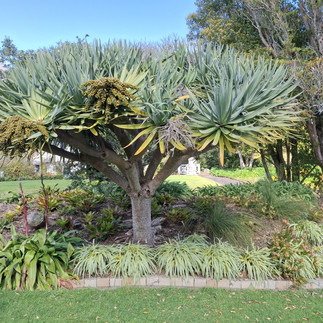Newsletter -September 2025
- pukekurafriends
- Sep 30
- 7 min read
Updated: Oct 1


Members Lunch
Midday, Wednesday 15 October 2025
Member’s Lunch (High Tea)
Pukekura Tea House, Pukekura Park
The cost is $25 per head.
Please RSVP by Sunday evening 10 October to Alison – treasurer@pukekura.org.nz
To confirm your booking, please pay $25 by internet banking to:
TSB Acc Name: Friends of Pukekura Park New Plymouth Incorporated
ACC No: 15-3953-0539316-01
Please ensure your name is included and “Members Lunch”
If you are unable to pay this way, please contact treasurer@pukekura.org.nz
The Friends look forward to seeing you there.
Events Programme October 2025
7th - Wanderers’ walk.
Magnolia Grove, 6 Mahoetahi Road Sentry Hill at 10.30am.
FOPP member Vance Hooper will show us around his amazing garden and his large selection of banana cultivars.
14th Committee meeting
15th Members’ lunch to be held at the Tea House at noon.
19th Plant Sale - Band Rotunda.
21st - Wanderers’ walk.
Note: No walk scheduled because of Member's Lunch and Plant Sale
23rd Evening Meeting
Citizens Advice Bureau, next to the Y.M.C.A. - 7pm
Matthew Allen: Bamboo - Matthew will talk about his experiences in growing bamboo and all the interesting things that can be done with this grass.
Review of September's Events
September 2nd - Wanderers’ walk.
Lead - Josh Paice
13 of us braved the weather to meet Josh Paice, arborist from NPDC.
Josh has just returned from 5 week’s fire fighting in Canada but unfortunately we didn’t have time for many tales of his time there.
Although chilly and fine, we viewed some of the trees and Josh commented on these. The main ones:
Fishtail palms in the Palm lawn. These had flowered and are laden with berries. The palms do not look healthy and apparently they die after flowering. This may take 3-4 years so we’ll be watching this space. It was interesting to see how the neighbouring Totara had been sculptured minimally to make space for the palms.
The Giant Redwood by the old Curator’s office proved an interesting study. Josh knocked on the bark to determine where the tree was solid and where it indicated a more hollow interior. We also looked at the bark where the tree is slowly growing new bark over a damaged area as a means of healing.
Moreton Bay Fig. This huge specimen is constantly monitored. It has grown above the other canopy and the branches are reaching out a long way. The buttress roots do not mind growing over the tarmac. Seeds are pollinated by a special type of wasp and seeds are spread probably by birds and/or bats.
The specimen was one of a few seedlings brought to New Plymouth by the Shearer family from Oakura in 1895.
Josh promises a demonstration of his tools of the trade next time – and maybe we can then see him in action.
I look forward to it.
16th - Wanderers’ Walk.
Lead - Tony Barnes
Good turnout of 17 arrived on a windy day with a forecast of possible showers. Tony Barnes, our lead, first took us around the plantings in the traffic island area. We admired the tall Mexican fan palm and a little later walked past the Chinese fan palms. These palms were not as tall and were distinguished by having fibre mats around the trunks. Tony described the various Agaves that were flowering and also the Aloes. The northern planting area had Pseudopanax Ferox (toothed lancewood) in its juvenile, intermediate and adult forms.
We then moved to the Gables plantings. The wind had dropped and the sun was out. The gardens were at their best. Tony talked about the magnolias and then pointed out an old daphne plant. He said they are normally in good health for around nine years and then started looking tired. Best to remove and replant at this stage rather than hope they will recover.
The Camellias were where Tony was in his good space. He told us about the history of the Camellia flower blight (parts of the petals turn brown) which is caused by a fungus Ciborinia camelliae, which was introduced in the 1990’s. There is still no cure and the blight is worse in New Zealand because it thrives in our humid conditions. The NZ Camellia Society have invested heavily in research to try and understand the disease and methods to reduce its impact. Three graduates had been sponsored over the last ten years to carry out the research. They have made good progress on understanding the disease but no cures to date. You can obtain limited control by good hygiene and fungicide sprays but it soon returns from trees in the neighbourhood outside of your control. We also discussed the lighter colour random streaks appearing on some of the camellia leaves and flowers. Tony said this was caused by viral variegation. The virus is systemic and cannot be cured.
All too soon time was up and although we didn’t walk all that far, we covered and learnt so much from Tony’s wealth of knowledge.
September 25th - Evening Meeting
Speaker - Elise Smith
Elise gave a fascinating talk about two very small and very ancient botanic gardens in Amsterdam and London. The Amsterdam Gardens, Hortus Botanicus was established way back in 1638 as a teaching and demonstration garden for doctors and chemists of the day.
Nowadays, its main role is to educate the public about the role of plants in our commercial world, and over the years, they have exported and imported potential new crops to their colonies. Elise was thrilled by the ancient palms and cycads on display; some of them over 200 years old.
The Chelsea Physic Garden on the banks of the Thames is marginally bigger at four acres, and was established in 1673 as a demonstration garden for herbs, spices and cures in the days of apothecaries, who were the pharmacists of the day.
Sir Hans Sloane, who rose from humble means to be one of the richest people in the world, bought the borough of Chelsea, including the garden, which he then rented out to the apothecaries for 5 pounds a year. Elise told us that this rental fee had not increased in 350 years, and so the garden still pays a rent of 5 pounds. Sloane’s private collection of natural curiosities became the basis of the British Museum.
For many years, the garden was a private repository for the study of cures and potions, but now it is open to the public six days a week, and has informative demonstrations for the public.
The garden contains a New Zealand section, and has a wonderful array of ferns from all over the globe. Elise was especially impressed by the greenhouses and the exotic plants within. Some of the plants are very rare, and some seemingly obscure for other reasons such as cannabis, and the mandrake root which supposedly screams when dug up.
From the Zoo
Wildlife Rehabilitation at Brooklands Zoo
At New Plymouth’s Brooklands Zoo, injured and unwell native birds are given tender-loving care until they’re fit for release back into the wild.
The zoo is approved by the Department of Conservation (DOC) to care for ill or injured native wildlife in off-display areas after they’ve been seen by a vet, and they usually stay for a few weeks of expert attention.
“The zoo staff love these feel-good moments when our wildlife rehab work has ended with a great result – seeing the birds fly off when they’re fit and well,” says Zoo Lead Eve Cozzi.
The majority of injuries that zoo staff see are due to predation (most likely by cats), vehicle collision or window strikes.
In the last 12 months, 13 native birds have been under the zoo’s care – mostly injured kererū, but also a kōtare (kingfisher), pāpango (New Zealand scaup) and ruru (morepork owl).
INTRODUCING NEW INDIVIDUALS TO ESTABLISHED GROUPS
Article from Red (Anthony) Brown – Brooklands Zoo Keeper
Occasionally we get the privilege of receiving new individuals and with established groups of animals there is quite the process to bring them into the environment.When these new individuals are born or hatched within the habitat, we do a lot of observations and make sure everyone is showing the right behaviours towards the infant, and vice versa.
However, when a new individual is being brought into a group, whether it’s a juvenile or fully developed adult, the process takes a little more finesse.
The first step is to ensure the newcomers aren’t harbouring any nasty illnesses that could get passed on to the current group, so they will be put into a quarantine period. The length of the quarantine and the testing required to ensure they are safe to introduce to our current residents depend on where the individuals have come from.
The next stages vary drastically depending on the species, but effectively we want to give our current groups and the newcomers a chance to acclimatise to each other. This gives the best chance for a successful introduction.
Some strategies we use are side-by-side contact, where the current group and the newcomers are held in separate spaces with a barrier between them – where possible in a neutral space and with an empty space between them. In this way, all the individuals can see, hear and smell each other without much or any ability to touch one another.
Initially this contact time would be very temporary, gradually increasing as we observe good natural behaviours that show us they are interacting well.
Following on from that, where available, we would introduce the newcomers to the current group in a neutral environment. This way we hope to have the whole group bond together in the new area as, especially with social groups, numbers equals safety.
Recently we went through this process with our meerkats with two new individuals arriving from Wellington Zoo. With each new step taken under a lot of observation, we successfully introduced Nandi and Zinzi and have increased our mob to five individuals.
Friends of Pukekura Park Membership Application Form
To apply for membership, either click on the link to our website page or download a pdf application form
Copyright © 2024 Friends of Pukekura Park, All rights reserved.
































































Comments